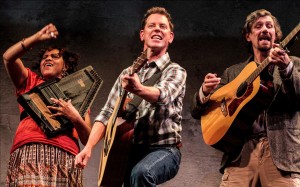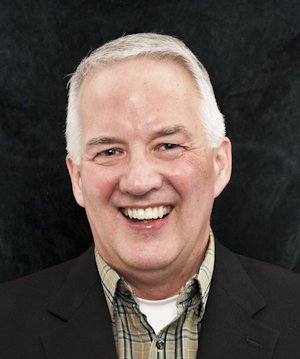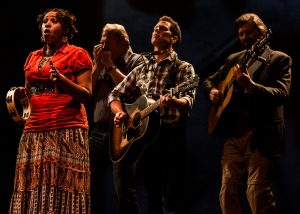Protest Goes Another Round at the REP
Second time’s a charm?
San Diego REP presented what management called the “world premiere workshop” production of A Hammer, A Bell, and a Song to Sing last January. At the time of that production, both the nation and the show itself were in a state of turmoil. The nation was reeling from the Occupy Wall Street demonstrations, including one not far from the Lyceum theatre, where the show was being produced. The show, which originally had been set to showcase the music of Pete Seeger, was reeling from Mr. Seeger’s late decision to deny rights to a show in his honor. The game cast (Vaughn Armstrong, Dave Crossland, and Jim Mooney) persevered through rewrites designed to focus the show on protest music and away from Mr. Seeger specifically.
Critics were not invited to review the show, though many of us saw it in January. It was clearly an “audience show,” with a fair amount of sing-along to what has become familiar music, mostly of the folk variety. All of the cast members were solid, but Mr. Crossland, a newbie to theatre, impressed with his tenor lead vocals – not surprising, as Mr. Crossland’s mentor was San Diego native John Stewart of the Kingston Trio.
The production resonated with the Occupy movement, and audiences responded enthusiastically.
Writer/Director and REP Associate Artistic Director Todd Salovey then had a bit of time to revise and reconsider, and the REP included the show in its 2012-13 season, calling it a “world premiere” once again.
It appears that Mr. Salovey has trimmed the show to 100 minutes without intermission, has traded out a couple of songs and revised some dialogue (which mostly consists of quotations from writers and politicians). He moved the show even further away from Pete Seeger than was true the January version, though Mr. Seeger still stands out among the composers and performers whose music is featured. His big change was to add Lisa Payton to the cast and to play up more of the gospel elements of the show to accommodate her strengths (though, she did a very nice job opening night singing a protest song from the Farm Workers movement in Spanish). The elements that made it such an audience favorite, especially the sing-along portion, have been enhanced.
 But, somehow the moment has passed. In January, we could empathize with a cast that had been assembled for a Pete Seeger tribute (Mr. Armstrong even looks a little like Mr. Seeger) and then had to revise suddenly when Mr. Seeger withdrew his support. We could root openly for the sympathetic comments about the Occupy movement. We could watch with studied horror as the Republican Party tried out an ever more conservative, anti-protest, set of presidential favorites.
But, somehow the moment has passed. In January, we could empathize with a cast that had been assembled for a Pete Seeger tribute (Mr. Armstrong even looks a little like Mr. Seeger) and then had to revise suddenly when Mr. Seeger withdrew his support. We could root openly for the sympathetic comments about the Occupy movement. We could watch with studied horror as the Republican Party tried out an ever more conservative, anti-protest, set of presidential favorites.
By November, the Occupy movement had faded into the background, President Obama had won a convincing re-election, and someone had let the air out of the show’s tires. The performers if anything had improved over January. Mr. Armstrong had become a better singer, Mr. Crossland a better actor (Mr. Mooney was always the mainstay of the instrumentals), and Ms. Payton was a reliable addition, both as a soloist and as part of the voice blend (Bruno Louchouarn served as music director and arranger).
But, the show still lacked focus (there’s a section on war protests, a second on civil rights, and then things all blended together), and Ms. Payton’s addition took a show that used to be about white males singing protest songs and suddenly made it seem lacking in representation. Yes, the ethnic protest songs were handled sensitively by the cast, but all of a sudden we noticed that there was one major group left out: gays and lesbians.
Now, gays and lesbians haven’t written protest songs, you might say, but think again. Holly Near’s “Singing for Our Lives” is about as within the genre the show presents as one might get, and her lesser-known “Great Peace March” would have made it as well. Singer and AIDS activist Michael Callen’s “Love Don’t Need a Reason” would have fit nicely, and if you can do the Rolling Stones you can do Gloria Gaynor’s “I Will Survive.” There was really no contemporary music in the show, but Lady Gaga’s “Born This Way” might have also created an interesting change-of-pace opportunity. [php snippet=1]
As a director, Mr. Salovey has run into some trouble, both in January and currently, with sightlines. He wants the performers to stand still and let the music do the talking, but doing so sometimes creates long periods where a performer will block another from audience view. This problem occurs more for patrons seated on the sides, so if you can sit in the center sections you will be happier. Otherwise, the production lived up to the usual REP standards (with scenic design by Giulio Cesare Perrone, costume design by Mary Larson, lighting design by Kristin M. Hayes, projection design by Victoria Petrovich, and a nicely unobtrusive sound design by Tom Jones).
A Hammer, A Bell, and a Song to Sing might well find a life in regional theatre. Patrons who saw and enjoyed it in January might well enjoy it again, though they should be prepared to see much the same show. If you missed it the first time, you have another chance to catch it. Performances run through December 2.
[box] Performs Wednesdays at 7, Thursdays through Saturdays at 8, and Saturdays and Sundays at 2 at the Lyceum Theatre in Horton Plaza. Ticket prices run $38 – $58. Check below for the REP box office phone number and web order link.
DOWNLOAD CAST AND CREDITS HERE[/box]
See a preview:

In addition to reviewing theatre for San Diego Story, Bill also reviews for TalkinBroadway.com. He is a member of the San Diego Theatre Critics Circle and the American Theatre Critics Association. Bill is an emeritus professor in the School of Journalism and Media Studies at San Diego State University.



